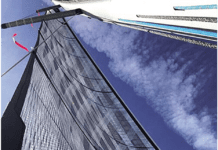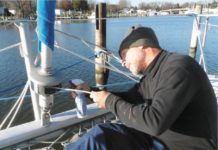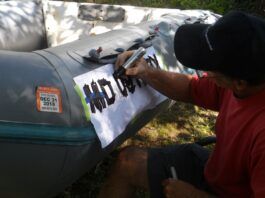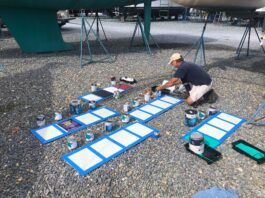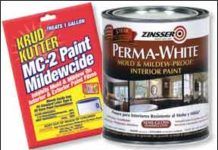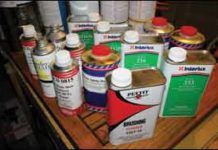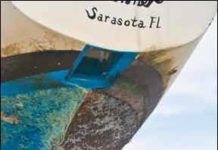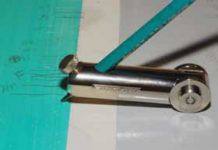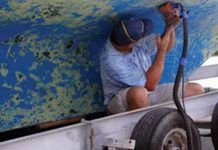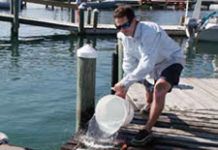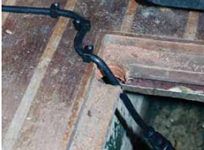Rope vs. Wire Lifelines
Three years ago, I bought a 1968 Hinterhoeller HR28 from a local junkyard that had paid $250 for it with plans to salvage the lead keel and Sawzall the rest. Ive spent almost three years on an amateurs refit. Now, I need new lifelines. I know that plastic-coated wire is out-of-favor and that race-sanctioning bodies now approve of high-tech (and high-priced) ropes. What risks am I taking if I just use a cheaper and thicker rope-something like Samson LS 3/8-inch with a tensile strength of 3,700 pounds? Stainless-steel 3/16 lifeline wire is rated at 3,700-pounds breaking strength. Are tensile and breaking strength the same?
Anti-Mildew Weapons
I was wondering whether you might have any comments on using bottom paint on the boats interior to help fight mold and mildew. Many bottom paints are ineffective out of the water, but I was wondering whether some of the new eco-friendly paints might prove to be a new weapon in the fight to work less and play more.
Mailport: June 2013
How thick is too thick for the buildup of old layers of bottom paint? This question arises because I have just finished painting the bottom of my boat. Even though I diligently sought out potential flaking spots with my knife, while rolling on the paint (Pettit Ultima Eco), I would frequently get a mess caused by the paint flaking off. I have only owned this boat for three years, so I really do not know how many layers there are.
Indoor Sailboat Refinishing
I am restoring old fiberglass sailing club boats (Rhodes 19s) in a confined, heated space in winter, and I need to paint the topsides, decks, and bilges without poisoning the applicator. What do you suggest for a topside finish (white)? A repairable, long-lasting finish will be valued more than a high-gloss finish. Also, what do you suggest for the bottom paint? The boats will be in fresh water all summer; low environmental toxicity is a high priority.
Practical Sailors Semi-annual Bottom Paint Test Checkup
In this article, our semi-annual report on antifouling paints for sailboats, testers rate two sets of paint panels-one that has been in the water 26 months, and the other for 15 months. We also take a peek at our newest panel, which has been in the water for only four months. Testers found a few surprises-especially among eco-friendly bottom paints-and tapped the top antifoulings for specific needs, like the best racing paint and the best aluminum-safe paint.
Topside-Paint Endurance Test 3-Year Checkup
Our topside-paint test panels have endured three full years of 24/7 exposure to the elements. Testers have regularly scrutinized the paint samples and rated the topside coatings on gloss retention, flow out, scratch resistance, and anti-oxidation ability. In this final round of evaluating, we also compared the panel results with the products real-world performances aboard our test boats over the last three-plus years. Top performers in the Practical Sailor tests included one-part urethane paints from Interlux, Epifanes, and Pettit, which all delivered handling convenience and a surprisingly long-lasting finish. The best two-part hull paints offered the most durability; picks in this group included coatings from Awlgrip, Interlux, and Sherwin-Williams, a good choice for the budget conscious boat owner.
Practical Sailor Tests Reveal Best Bottom Paints
Practical Sailor is simultaneously field-testing three sets of ablative and hard bottom paints in the high-fouling waters of Sarasota, Fla. One test panel has been in the water 36 months, another for 20, and a batch of new and eco-friendly paints has spent nine months submerged. This article covers the results of all three tests and highlights the best bottom paints in each test field, including Practical Sailors picks for aluminum-friendly paints, water-based paints, eco-friendly paints, racing paints, and budget-priced antifouling paints. The test field included dozens of bottom paints from Blue Water Paints, Interlux, Epaint, Pettit, Sea Hawk, Flexdel, and Boero.
First Look at New Eco Paints and ‘Hard’ Ablatives
In late 2011, Practical Sailor launched a test that focused exclusively on new antifouling paints that had been introduced in the previous year or that we had never tested before. Along with regular test participants Blue Water, Epaint, Flexdel, Pettit, and Sea Hawk, several newcomers signed on, including Specialty Marine Solutions, a Massachusetts company that has developed paints using Sea-Nine 211, a marine antifouling agent from Dow Chemical; Boero, an Italian company with a long history in Europe; and Luritek, a company based in West Chester, Penn.
First Look at New Eco Paints and Hard Ablatives
In late 2011, Practical Sailor launched a test that focused exclusively on new antifouling paints that had been introduced in the previous year or that we had never tested before. Along with regular test participants Blue Water, Epaint, Flexdel, Pettit, and Sea Hawk, several newcomers signed on, including Specialty Marine Solutions, a Massachusetts company that has developed paints using Sea-Nine 211, a marine antifouling agent from Dow Chemical; Boero, an Italian company with a long history in Europe; and Luritek, a company based in West Chester, Penn.
A Copper Alternative?
Prompted by several reader queries and our own curiosity, Practical Sailor recently launched a test of an electronic alternative to metal-based bottom paints: the M20, an ultrasonic antifouling device from the Canada-based SmartAntifouling. Electronic antifouling uses ultrasound waves to prevent algae and other organisms from attaching to a boat’s hull. A transducer, which is mounted on the hull skin inside the boat, emits a high-frequency vibration that creates a micro-thin layer of rapidly moving water blanketing the hull and making it difficult for barnacles and algae to take up residence there. PS installed an M20 on a Florida-based test boat and will be monitoring its performance this season.













